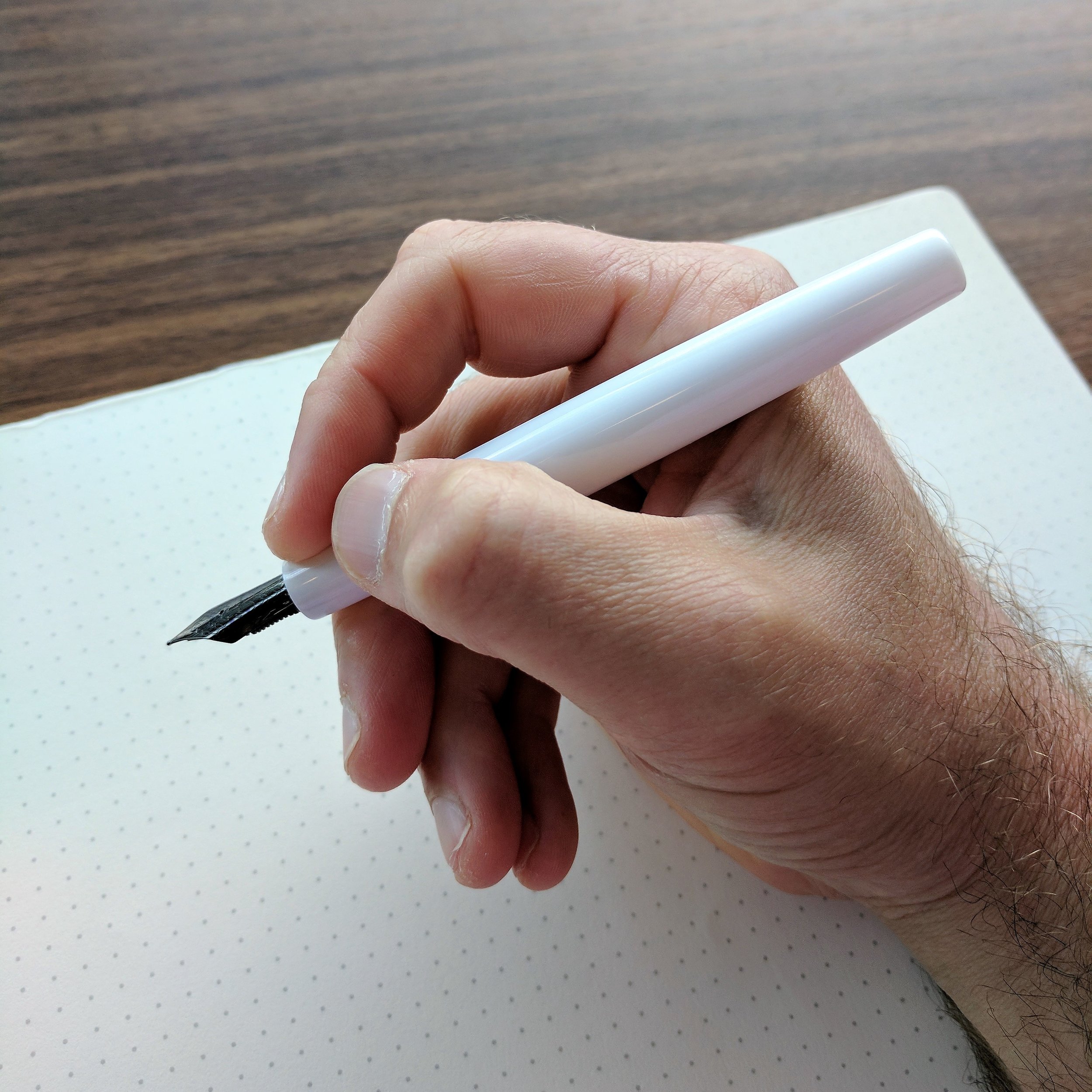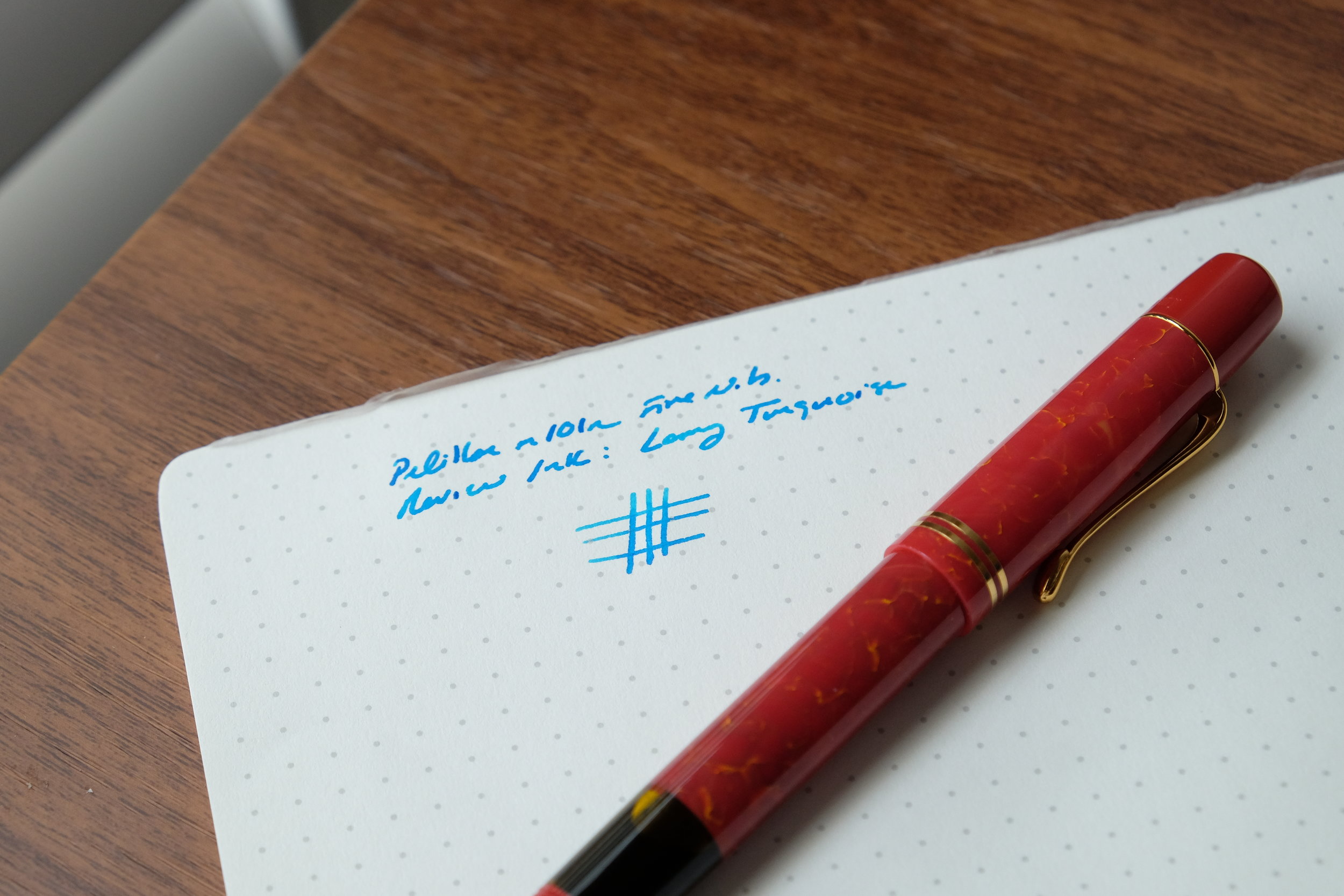Montegrappa is one of those brands that didn't make it onto my radar until relatively recently, when I was offered the opportunity to borrow one of their higher-end Passione pens in a stunning red celluloid. My positive experience with that pen got me interested in learning more about the brand, so I placed an order for a Montegrappa Fortuna in white with ruthenium trim. At the same time, Cary at Kenro Industries (Montegrappa's U.S. distributor) loaned me two additional pens: the recently released Fortuna Silver and one of last year's "it" pens, the Montegrappa Mule, which is essentially a copper and steel Fortuna. (You may recall seeing photographs from "Mule parties" on the pen show circuit.)
First Impressions
Aesthetically, the Fortuna ticks all the right boxes for me. I love the shape of this pen, which is a variant of the classic cigar shape and fits into my hand nicely. I also appreciate the classic, understated design - not always something that I can say about Montegrappa pens, especially on some of their more elaborate creations.
The coating on the brushed stainless steel Fortuna Silver reflects the light in a way that makes the pen appear to have varying shades of light and dark. The effect is very attractive and gives what would otherwise be a relatively plain stainless steel pen a more unique look.
The build on these pens is quite sturdy - you don't have to worry about the Fortuna (and certainly not the copper and steel versions) holding up to the rigors of everyday use. All feature very tight "rollerball" clips, and if I had one critique on the build it would be that the clips are too tight - it's often hard to get this pen to clip to a shirt pocket or a pen slot in one of my bags.
Montegrappa Fortuna engraved cap band and "roller" clip
These pens also feature metal threads, which is likely a good thing for durability, but at least on my white Fortuna causes the threads to "squeak" a little bit when capping/uncapping. The noise is less pronounced on the all-metal pens, so it may have something to do with the black coating on the trim. One thing I do appreciate is that while the barrel threads are metal, the internal threads (on the inside of the cap) are plastic, even on the Mule and Fortuna Silver. That way, when you post the pen the threads won't scratch the barrel, as pretty much always happens to any other pen with a metal cap. (Montblanc, take a hint here.)
Writing Experience
All three of the Fortunas were extremely comfortable writers. The acrylic pen is a fairly light pen, and the easiest to write with for an extended period of time. The metal threads at the front of the pen give it a nice forward balance with good control. Even the (much) heavier Fortuna Silver (made of stainless steel) and the Mule (made of copper) don't feel too heavy, due to the shape of the pen and how the weight is distributed. I could use any of these three pens posted or unposted, which surprised me a bit because all-metal pens typically tire my hand out after about a page. Montegrappa did an excellent job of designing around an issue which could potentially make the Mule and the Fortuna Silver unusable for a lot of people.
While some have experienced flow issues with the Fortuna nibs, these three pens all wrote well without any hard starting or skipping. Should you experience problems with your nib, I'd first clean the pen with a bit of soapy water (use diluted dish soap) or pen flush to rinse out any manufacturing residue (oils, debris, etc.), and if the problems continue notify your retailer or Kenro, who will take care of you. I've not heard much about this recently, so Montegrappa may have resolved any production issues.
Of these three pens, the white is my favorite, mainly because of the nib. For some reason that I've not (yet) taken the time to research, black ion or ruthenium-plated nibs tend to be a touch softer than standard gold or steel nibs. They're not "flexible" by any means, but they do have a bit more bounce to them. The standard steel nib on the Fortuna Silver and the Mule was definitely drier and stiffer than the black plated nib on the white acrylic pen. I've noticed the same thing on my black ion-plated Sailor Professional Gear Imperial Black and Sailor 1911 Black Luster fountain pens - they're both softer than the standard Sailor gold nibs, which are notorious nails.
Another note on the plated nibs - they have a tendency to corrode when used with inks containing iron gall. I made the mistake of using Montblanc Midnight Blue (old formulation) and Montegrappa Blue Black with this nib, which resulted in the plating wearing away around the nib slit and at the base of the nib. Be warned.
Montegrappa nibs, in my experience, also write narrower than their designation. The Mule and the Fortuna Silver both had broad nibs that to me were really classic mediums. I'm typically not a "broad nib" person because I do a lot of copy editing and margin annotations at work and need to write fairly small, but I could use this Montegrappa broad nib easily. Even so, I still preferred the medium nib on the white/ruthenium pen. It wrote a consistently wet line and even offered some stub-like line variation on the cross strokes.
Takeaways and Where to Buy
Most Montegrappa retailers such as Vanness Pens and Pen Chalet will carry the Fortuna, especially since Montegrappa seems to be making the Fortuna line its primary - and certainly its most accessible - line of pens. That said, "accessibility" is relative, and these pens still come with a luxury premium on the price. The White/Ruthenium Fortuna retails for $290, and the Mule sells for $375. The recently released Fortuna Silver is priced at $395. Montegrappa is fairly insistent on retailers adhering to their standard pricing, and while you can sometimes find a slight discount off of MSRP, it's rare.
Are these pens worth the money? As always, it depends on what you are looking for. You can certainly find excellent writers with gold nibs for less money, and I'd personally be hard-pressed to choose the Fortuna over a Sailor Pro Gear, which can be less expensive and is possibly my favorite pen of all time. Price notwithstanding, the size and feel of the Fortuna make it an extremely comfortable pen to use, and Montegrappa has released this pen in some unique, beautiful designs and color schemes, which is the real value here. I highly encourage you to check out the Mosaico Marrakech, as well as the upcoming Fortuna "Heartwood" line.
A big thank you to Kenro Industries for making this review possible, and I look forward to seeing what else Montegrappa has in store for the Fortuna line.
Disclaimer: I received a discount on my purchase of the White Fortuna directly from Kenro, who also loaned me the Montegrappa Mule and Silver Fortuna for review purposes. This post contains links to affiliates and sponsors.







